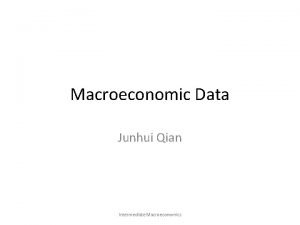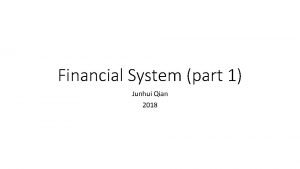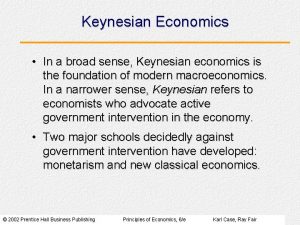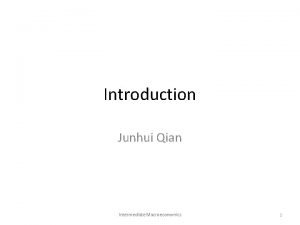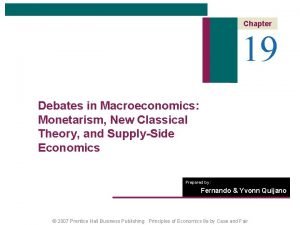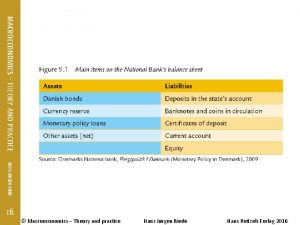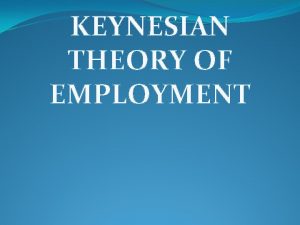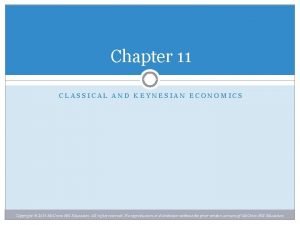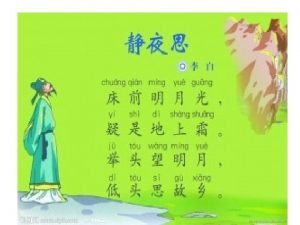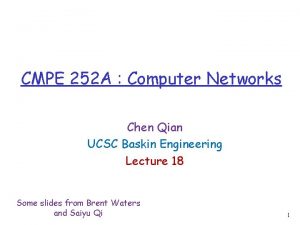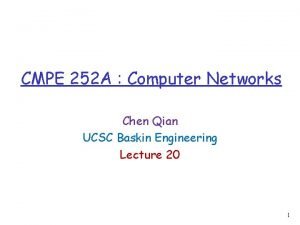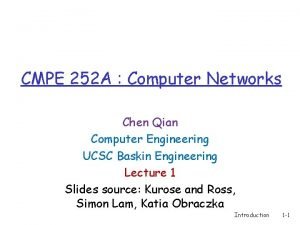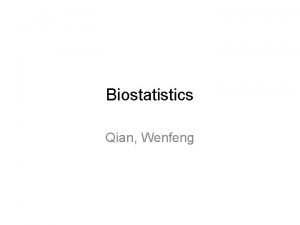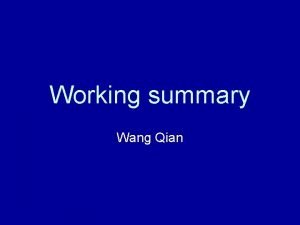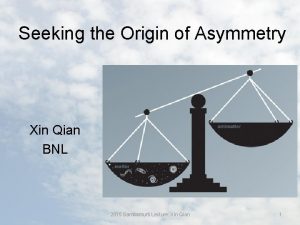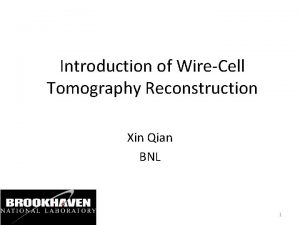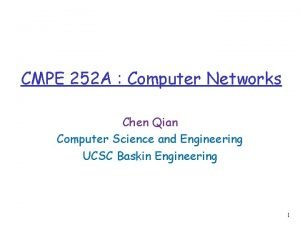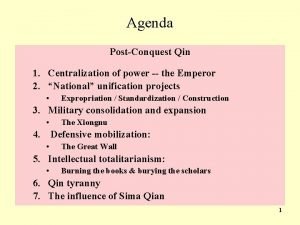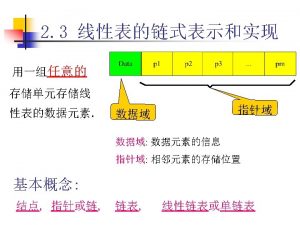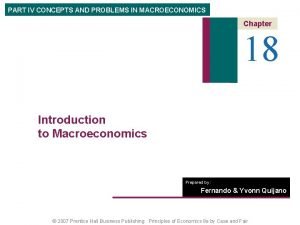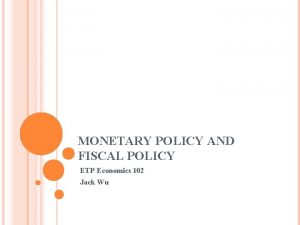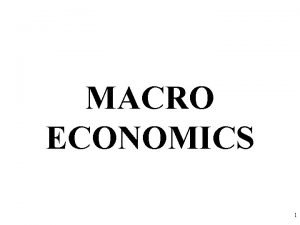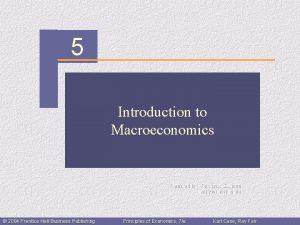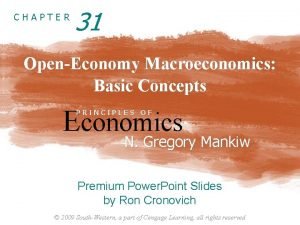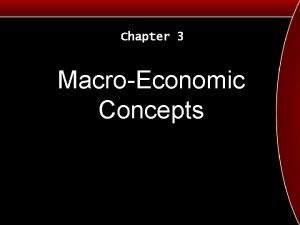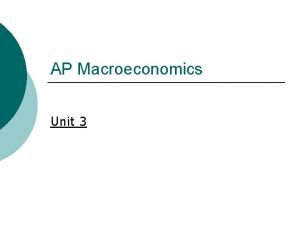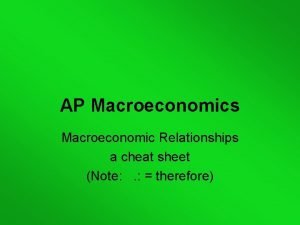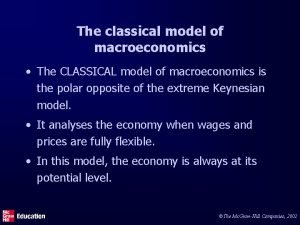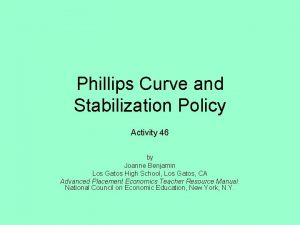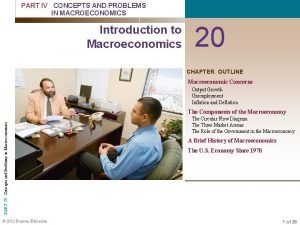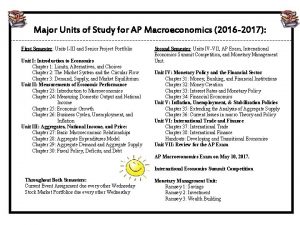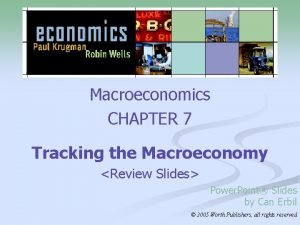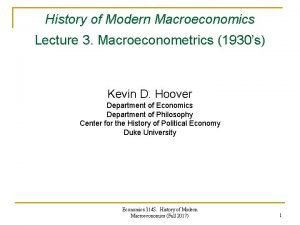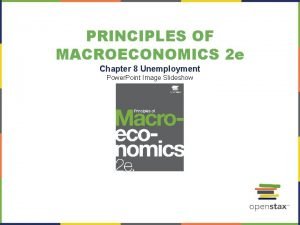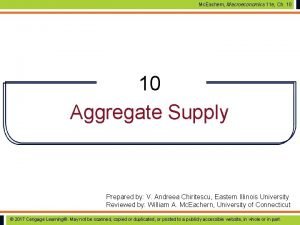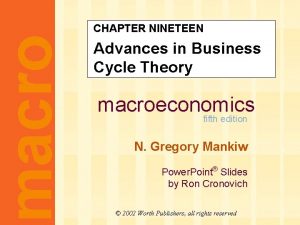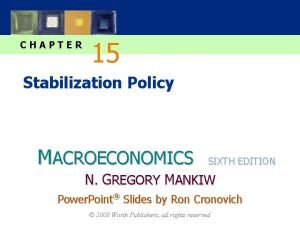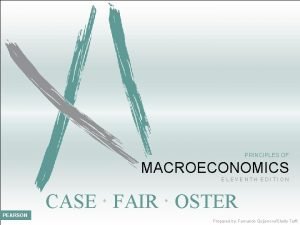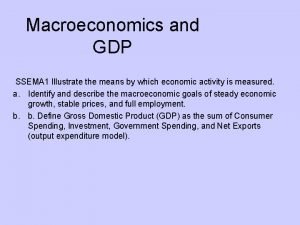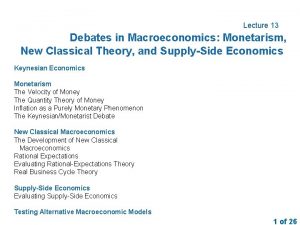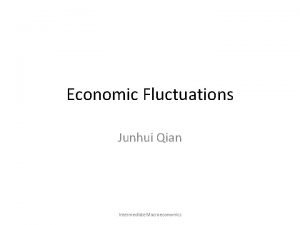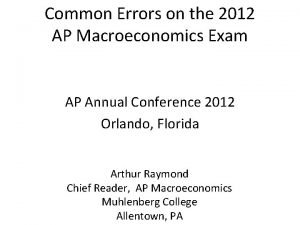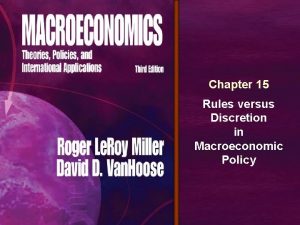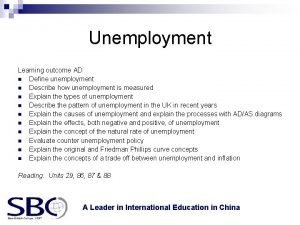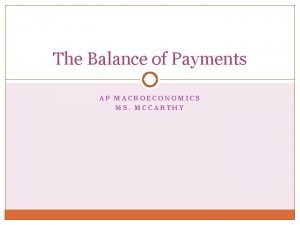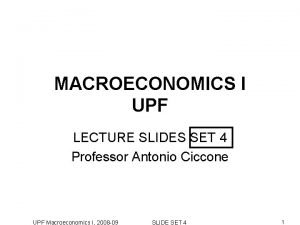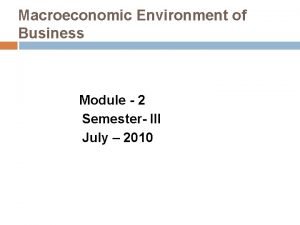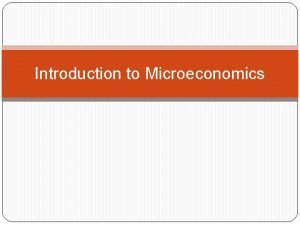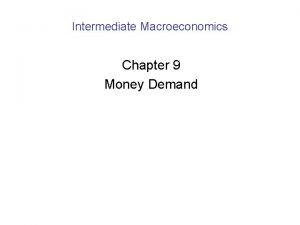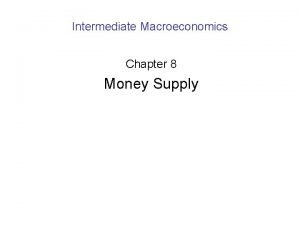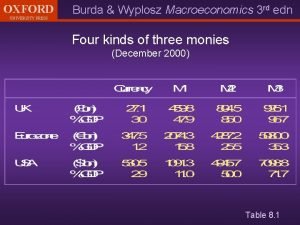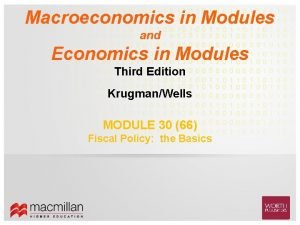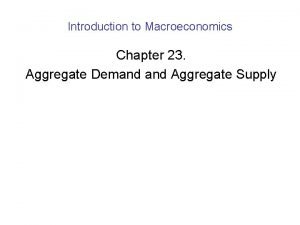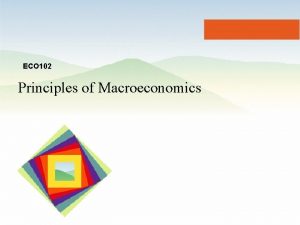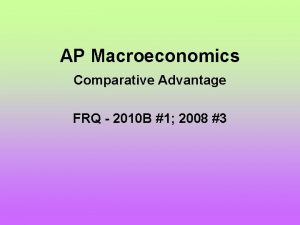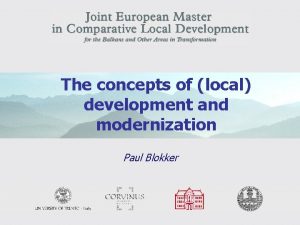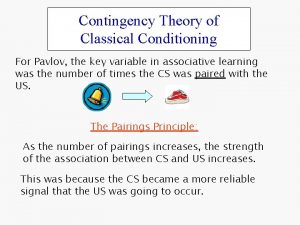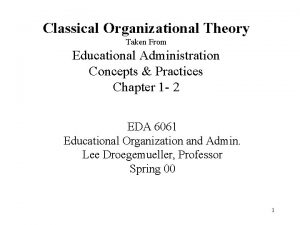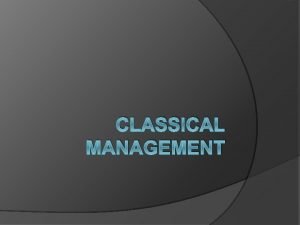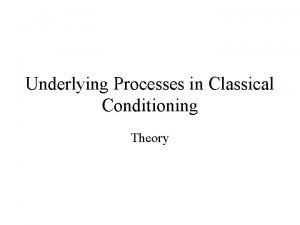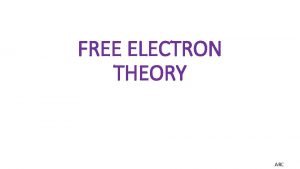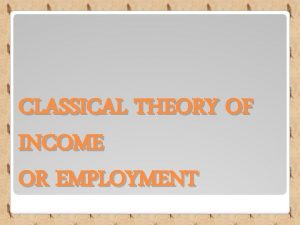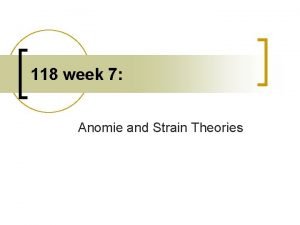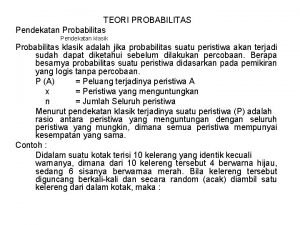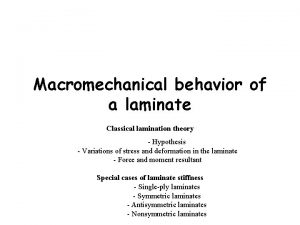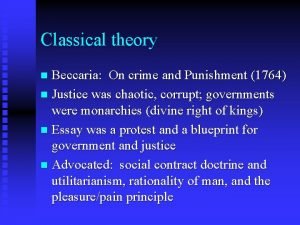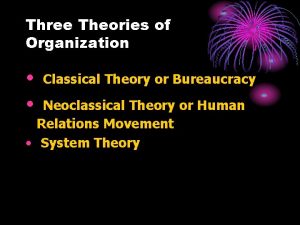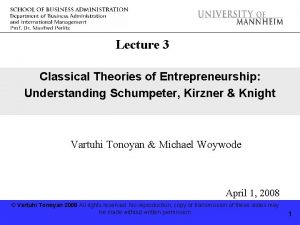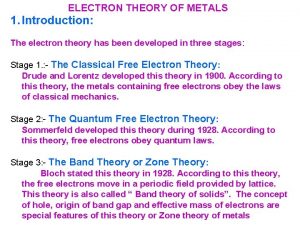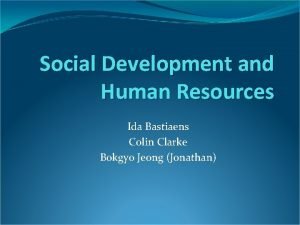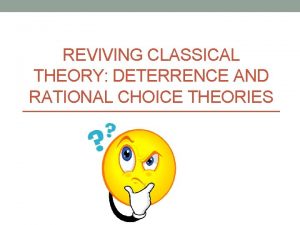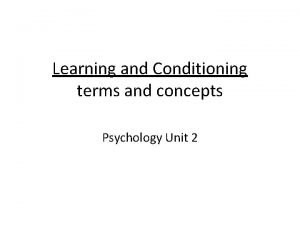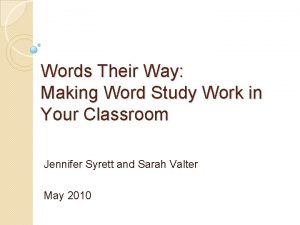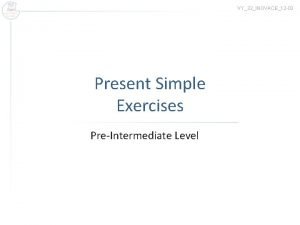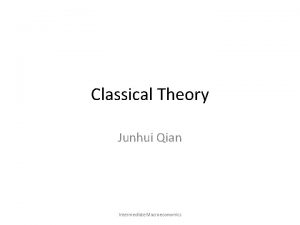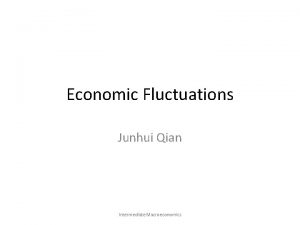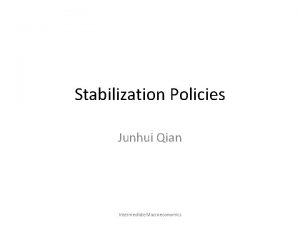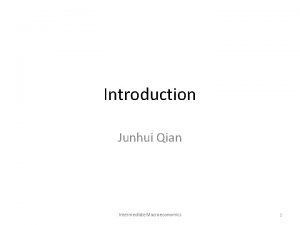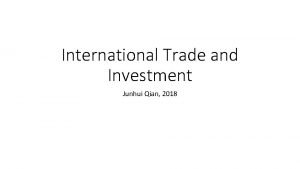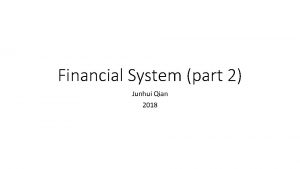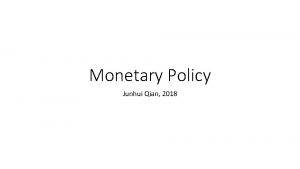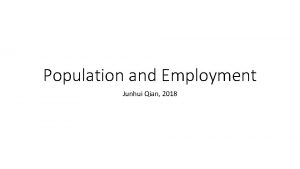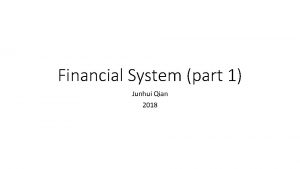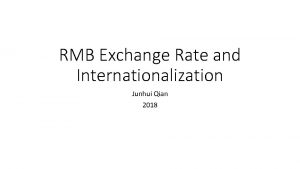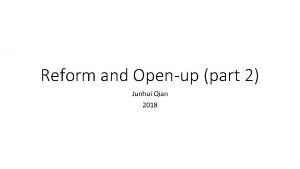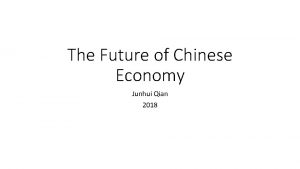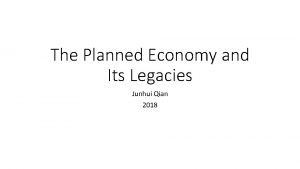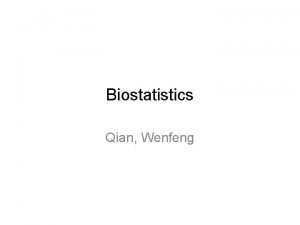Classical Theory Junhui Qian Intermediate Macroeconomics Content Output





























































































































- Slides: 125

Classical Theory Junhui Qian Intermediate Macroeconomics

Content • • • Output Unemployment Income Distribution Real Interest Rate and Investment Inflation and Nominal Interest Rate Exchange Rate Intermediate Macroeconomics

Output of an Economy as a Whole • An economy’s output of goods and services depends on: – Aggregate Supply (AS, the supply side) • Quantity of inputs (called the factors of production): labor, capital, land, etc. • The technology that transforms inputs into outputs – Aggregate Demand (AD, the demand side) • Consumption, investment, government expenditure, and net foreign demand Intermediate Macroeconomics

The AD and AS • AD is the “sum” of all demand for goods and services. • AS is the “sum” of all supply of goods and services. – Both AD and AS are in the “real” sense: when we say AD or AS changes, it is the quantity of goods and services that changes. – The summation is tricky for heterogeneous goods and services. – The solution: add up the value of these goods and services at constant prices. Intermediate Macroeconomics

The AD and AS Curves • Intermediate Macroeconomics

The Classical AD and AS Curves The AD and AS Curves Intermediate Macroeconomics

Say’s Law • Say’s Law states: supply creates its own demand. – It necessarily holds in a barter economy. – It does not generally hold in the modern monetary economy. • One implication of Say’s Law: the AD curve coincides with the AS curve at all price level. – The general price level is determined by money supply (quantity theory of money) and is irrelevant to “real” activity of the economy. Intermediate Macroeconomics

The Output Potential • Intermediate Macroeconomics

Factors of Production • Factors of production are the inputs for producing goods and services. • The two most important factors of productions are capital and labor. (Land is also regarded as a factor of production. ) • Capital refers to the set of tools that workers use. We use K to denote the amount of capital. • Labor refers to the time workers spend working. We use L to denote the amount of labor. Intermediate Macroeconomics

A Simplification Assumption • Intermediate Macroeconomics

Production Function • Intermediate Macroeconomics

Assumptions on the Production Function • Intermediate Macroeconomics

The Cobb-Douglas Production Function • Intermediate Macroeconomics

The Output of Goods and Services • Intermediate Macroeconomics

Content • • • Output Unemployment Income Distribution Real Interest Rate and Investment Inflation and Nominal Interest Rate Exchange Rate Intermediate Macroeconomics

Unemployment • There is no unemployment problem when factor inputs are (almost) fully utilized. However, the unemployment rate is nonzero even in the idealized classical economy. • In this part of the lecture, we discuss the “natural rate of unemployment” that happens in the classical economy with flexible prices (wages). • A simple model • Frictional unemployment Intermediate Macroeconomics

The Unemployment Rate and the Natural Rate of Unemployment in US Intermediate Macroeconomics

A Model of Natural Unemployment • Intermediate Macroeconomics

The Natural Unemployment Rate • Intermediate Macroeconomics

The Implications • This simple model relates the natural unemployment rate to the rate of job separation and the rate of job finding. • Any policy aiming to lower natural unemployment rate must either decrease the rate of job separation or make it easier to find jobs. • The model, however, does not explain what causes unemployment. Intermediate Macroeconomics

Frictional Unemployment • It takes time to find a job or find a worker. The unemployment due to this simple fact is called frictional unemployment. • The friction comes from – Heterogeneities of jobs and workers, – Imperfect information, – Imperfect labor mobility, – Sectoral shifts. Intermediate Macroeconomics

Policy Responses to Frictional Unemployment • Frictional unemployment is an important component of natural unemployment. • To reduce frictional unemployment, governments usually do the following: – Help disseminate information about jobs. – Provide training programs • The government may also provide unemployment insurance. – Unemployment insurance helps soften the economic hardship of the unemployed. Hence it may contribute to higher natural unemployment. – However, unemployment insurance reduces workers’ uncertainties about their income and also, helps to achieve a better matching between workers and jobs. Intermediate Macroeconomics

Structural Unemployment • The structural unemployment is caused by wage rigidity, the failure of real wage adjustments. Real wage Labor supply Unemployment Rigid real wage Labor demand Labor Intermediate Macroeconomics

Causes of Wage Rigidity • Minimum wage – The minimum wage v. s. earned income tax credit debate • Labor union – “Insiders”, through collective bargaining, achieves to keep their firm’s wage high. – To give more influence to “outsiders”, wage bargaining can take place at national level (e. g. , Sweden). • Efficiency wage – High wage reduces labor turnover. – High wage mitigates the problem of adverse selection. – High wage mitigates the problem of moral hazards. Intermediate Macroeconomics

Content • • • Output Unemployment Income Distribution Real Interest Rate and Investment Inflation and Nominal Interest Rate Exchange Rate Intermediate Macroeconomics

Distribution of Income • Under the classical assumptions, the total output is fixed, so the total income is also fixed. We now discuss how the income is distributed. • The income is distributed to those who provide inputs, that is, those who provide capital and those who provide labor. • Factor prices (real wage and real rental price of capital) are crucial for the determination of the distribution. Intermediate Macroeconomics

Factor Prices • Intermediate Macroeconomics

Competitive Markets • Markets for goods and services are competitive. • Markets for factors of production (labor and capital) are competitive. (A market is competitive if no participants are large enough to affect prices. In other words, all market participants are price takers. ) Intermediate Macroeconomics

Decisions of A Competitive Firm • Intermediate Macroeconomics

The Solution • Intermediate Macroeconomics

Demand for Labor • Intermediate Macroeconomics

A Labor Demand Curve Intermediate Macroeconomics

Economic Profit and Accounting Profit • Intermediate Macroeconomics

Distribution of National Income • Intermediate Macroeconomics

The Cobb-Douglas Economy • Intermediate Macroeconomics

Case Study: Labor’s Share of Income in USA Intermediate Macroeconomics

Case Study: Labor’s Share of Income in China 70 68 66 64 62 60 58 56 54 52 1993 1994 1995 1996 1997 1998 1999 2000 2001 2002 2003 2004 2005 2006 2007 2008 2009 2010 2011 2012 2013 2014 2015 2016 Intermediate Macroeconomics

Average Labor Productivity and Real Wage • Intermediate Macroeconomics

Case Study: Labor Productivity and Real Wage in USA Growth in labor productivity (%) Growth in real nonfarm compensation (%) 1959 -1972 2. 8 2. 3 1973 -1994 1. 6 0. 7 1995 -2007 2. 7 1. 6 2008 -2019 1. 3 0. 8 1959 -2019 2. 1 1. 3 Why does real wage growth lag behind the labor productivity growth? Intermediate Macroeconomics

Content • • • Output Unemployment Income Distribution Real Interest Rate and Investment Inflation and Nominal Interest Rate Exchange Rate Intermediate Macroeconomics

A Classical Model of Real Interest Rate • In the following we present a classical macroeconomic model of real interest rate. • The model contains an equilibrium restriction and a set of behavioral assumptions. • We will use the model to examine the effects of external shocks on a closed economy. Intermediate Macroeconomics

Another Interpretation of the National Income Accounting Identity • Intermediate Macroeconomics

A Simplification: Closed Economy • Intermediate Macroeconomics

Consumption Function • Intermediate Macroeconomics

Marginal Propensity to Consume • Intermediate Macroeconomics

Investment Function • Intermediate Macroeconomics

Nominal and Real Interest Rates • Intermediate Macroeconomics

Ex-ante Real Interest Rate • Intermediate Macroeconomics

Fiscal Policy • Intermediate Macroeconomics

Equilibrium in the Goods Market • Intermediate Macroeconomics

National Saving • Intermediate Macroeconomics

Equilibrium in the Financial Market • Intermediate Macroeconomics

Determination of Real Interest Rate Equilibrium real interest rate Intermediate Macroeconomics Investment

The Effects of Fiscal Policies • We now use our model to examine the effects of fiscal policies on the economy. – An increase in government spending – A tax reduction Intermediate Macroeconomics

An Increase in Government Spending Equilibrium real interest rate Intermediate Macroeconomics Investment

The Crowding-Out Effect • The model predicts that an increase in government expenditure would reduce national saving. This leads to higher interest rate and lower investment. Economists would say that government spending “crowds out” the private investment. • What about the effect of tax reduction on the economy? Intermediate Macroeconomics

A Surge in Investment Enthusiasm • A surge in investment enthusiasm implies that, given any real interest rate, the investment demand for the loanable funds would increase. • That is, the demand curve would shift to the right. Intermediate Macroeconomics

Changes in Investment Demand Equilibrium real interest rate Intermediate Macroeconomics Investment

A Modified Model • Intermediate Macroeconomics

A More Realistic Saving Curve Equilibrium real interest rate Investment Intermediate Macroeconomics

Content • • • Output Unemployment Income Distribution Real Interest Rate and Investment Money, Inflation and Nominal Interest Rate Exchange Rate Intermediate Macroeconomics

Money • Money is the stock of assets that can be readily used to make transactions. • Functions of money: – Store of value – Unit of account – Medium of exchange • Types of money: – Commodity money (gold, silver) – Fiat money Intermediate Macroeconomics

How Fiat Money Comes About • Transactions using commodity money (say gold) is costly. • To reduce transaction cost, a bank may mint gold coins of known purity and weight. • To further reduce cost, the bank may issue gold certificates, which can be redeemed for gold. The gold certificate becomes goldbacked money. • The need for transactions is unlimited, but the supply of gold is limited. Hence the limited supply of gold has a deflationary effect on the economy, if the bank sticks to the gold standard of money. • If people do not care about the option of redeeming gold, however, the bank can issue certificates that are not backed by gold in vault. The modern central bank does exactly this, and these certificates are fiat money. • Fiat money is valued because people expect it’s valued by everyone else. Intermediate Macroeconomics

Case Studies • Money in a POW (prison of war) Camp • Money on the Island of Yap Intermediate Macroeconomics

Monetary Policy • Monetary policy is the process by which the monetary authority of a country controls the supply of money, often targeting an interest rate for the purpose of promoting economic growth and stability. • The monetary authority in China is People’s Bank of China (PBC), that in USA is the Federal Reserve (the Fed). Intermediate Macroeconomics

Seigniorage: Another Reason for Printing Money • In normal times, the central bank increase money supply to accommodate increasing demand for money. • At the same time, by printing money, the central bank contributes revenue to the government, often by purchasing government bonds. The revenue from printing money is called seigniorage, or “inflation tax”. • In normal times, seigniorage is moderate. In some extreme situations (war, hyperinflation, etc), seigniorage may contribute the majority of government revenue. Intermediate Macroeconomics

Money in Modern Economy • Money in a modern economy may include: – Cash – Demand deposits – Saving deposits – Money market funds Intermediate Macroeconomics

How Money Supply is Measured in USA Measures of Money Stock Amount (billion USD) Assets included 2008 2014 C Currency 818. 9 1254. 1 M 1 Currency plus demand deposits, traveler's checks, and other checkable deposits 1631. 9 2973. 4 M 2 M 1 plus retail money market mutual fund balances, saving deposits (including money market deposit accounts), and small time deposits. 8207. 5 11714. 3 Intermediate Macroeconomics


Case Study: M 2/GDP Ratio • The ratios of M 2/GDP differ across economies. M 2/GDP (%, 2012) China 180. 1 USA 64. 2 EU 92. 4 Japan 170. 4 • Generally speaking, M 2/GDP is high in economies where banks dominate the financial sectors. Intermediate Macroeconomics

Inflation • Definition: Inflation is a sustained increase in the general price level of goods and services in an economy over a period of time. • Measurement: CPI and GDP deflator. • Relationship between money and inflation: Inflation erodes purchasing power of money. Intermediate Macroeconomics

Costs of Inflation • Expected Inflation – Shoeleather cost – Menu cost – Relative price distortion – Unfair tax treatment – General inconveniences • Unexpected inflation – Arbitrary redistributions of purchasing power – Increased uncertainty Intermediate Macroeconomics

One Benefit of Inflation • Nominal wages are rarely reduced, even when the equilibrium real wage falls. • Inflation allows the real wages to reach equilibrium levels without nominal wage cuts. • Therefore, moderate inflation improves the functioning of labor markets Intermediate Macroeconomics

Hyperinflation • Definition: Inflation exceeds 50% per month • All the costs of moderate inflation described above become HUGE under hyperinflation. • Money ceases to function as a store of value, and may not serve its other functions (unit of account, medium of exchange). • People may have to barter or use a stable foreign currency. Intermediate Macroeconomics

Case Study: Hyperinflation in Nationalist China Money and Price in 1937 -1948 10000000 100000 1000 10 1 1937 -12 1938 -12 1939 -12 1940 -12 1941 -12 Money Supply (billion) 1942 -12 1943 -12 1944 -12 Shanghai Wholesale Price Index Intermediate Macroeconomics 1945 -12 1946 -12 1947 -12

Case Study: Hyperinflation in Nationalist China Money and Price from 1948. 8 to 1949. 4 100000 1000 10 1 Aug-48 Sep-48 Oct-48 Nov-48 Dec-48 Jan-49 0. 1 Money Supply (billion) Shanghai Wholesale Price Index Intermediate Macroeconomics Feb-49 Mar-49 Apr-49

What Causes Hyperinflation? • An easy answer is: hyperinflation is caused by excessive money supply growth. • When the central bank prints money, the price level rises. If it prints money rapidly enough, the result is hyperinflation. • But why do central bank print money? It’s the fiscal problem, in most cases! • How can hyperinflation be halted? Fiscal reform in most cases. Intermediate Macroeconomics

Quantity Theory of Money: From The Perspective of Transactions • Intermediate Macroeconomics

Quantity Theory of Money: From The Perspective of Income • Intermediate Macroeconomics

Quantity Theory of Money: From The Perspective of Money Demand Supply • Intermediate Macroeconomics

Money and Inflation • Intermediate Macroeconomics

19 7 19 8 7 19 9 8 19 0 8 19 1 8 19 2 8 19 3 8 19 4 8 19 5 86 19 8 19 7 8 19 8 89 19 0 9 19 1 9 19 2 9 19 3 9 19 4 9 19 5 9 19 6 9 19 7 9 19 8 9 20 9 0 20 0 0 20 1 0 20 2 0 20 3 0 20 4 0 20 5 0 20 6 0 20 7 0 20 8 0 20 9 1 20 0 1 20 1 1 20 2 13 20 1 20 4 1 20 5 1 20 6 1 20 7 18 Case Study: M 2 Growth and Inflation in China Infaltion and Money Growth 40. 0 35. 0 30. 0 25. 0 20. 0 15. 0 10. 0 5. 0 0. 0 -5. 0 Inflation M 2 Growth Intermediate Macroeconomics

Case Study: U. S. Inflation and Money Growth Intermediate Macroeconomics

Case Study: Money Growth and Inflation Across Countries Intermediate Macroeconomics

59 85 Intermediate Macroeconomics 01 05 09 17 20 15 20 13 20 11 20 20 07 20 20 03 20 20 99 19 97 19 95 19 93 19 91 19 89 19 87 19 19 83 19 81 19 79 19 77 19 75 19 73 19 71 19 69 19 67 19 65 19 63 19 61 19 19 Case Study: Money Velocity of USA Money Velocity (Nominal GDP/M 2) 2. 5 2 1. 5 1 0. 5 0

Case Study: Money Velocity of China Money Velocity (Nominal GDP/M 2) 1. 4 1. 2 1 0. 8 0. 6 0. 4 0. 2 0 1991 1992 1993 1994 1995 1996 1997 1998 1999 2000 2001 2002 2003 2004 2005 2006 2007 2008 2009 2010 2011 2012 2013 2014 2015 2016 2017 2018 Intermediate Macroeconomics

Inflation and Nominal Interest Rate • Intermediate Macroeconomics

Case Study: Inflation and Nominal Interest Rate in USA Intermediate Macroeconomics

Case Study: Inflation and Nominal Interest Rate Across Countries Intermediate Macroeconomics

An Integrated Model • Intermediate Macroeconomics

Classical Dichotomy • Intermediate Macroeconomics

Criticism of the Classical Dichotomy • Intermediate Macroeconomics

Money Demand Nominal Interest Rate • Intermediate Macroeconomics

The Money Demand Function • Intermediate Macroeconomics

Money and Inflation • Intermediate Macroeconomics

Content • • • Output Unemployment Income Distribution Real Interest Rate and Investment Inflation and Nominal Interest Rate Exchange Rate Intermediate Macroeconomics

The Open Economy • An open economy trades with other economies in the world. • In this part of the lecture, we discuss – The international flows of goods and capital – Exchange rate – A model of small open economy – A model of large open economy Intermediate Macroeconomics

The Importance of Trade Intermediate Macroeconomics

19 7 19 8 7 19 9 80 19 8 19 1 8 19 2 83 19 8 19 4 8 19 5 8 19 6 8 19 7 8 19 8 8 19 9 9 19 0 9 19 1 9 19 2 9 19 3 9 19 4 9 19 5 9 19 6 9 19 7 9 19 8 9 20 9 0 20 0 0 20 1 0 20 2 0 20 3 0 20 4 0 20 5 0 20 6 0 20 7 0 20 8 0 20 9 1 20 0 1 20 1 1 20 2 1 20 3 1 20 4 1 20 5 16 20 1 20 7 18 How China Depends on Trade Export/GDP Import/GDP 40. 0 35. 0 30. 0 25. 0 20. 0 15. 0 10. 0 5. 0 0. 0 Intermediate Macroeconomics

Net Export • Intermediate Macroeconomics

Current Account • Trade balance is the most important part of the current account. We have CA = trade balance + net factor income + net cash transfer • Current account surplus: if CA>0 • Current account deficit: if CA<0 • In this course we ignore net factor income and cash transfer and treat current account balance as the same thing as trade balance. Intermediate Macroeconomics

The Recent Trend of China’s Current Account Intermediate Macroeconomics

Capital Flow • Intermediate Macroeconomics

An Imagined Example • If BYD sells an electric car to a US consumer for $10, 000, how does the sale change China’s trade and capital flow? Intermediate Macroeconomics

Capital Account • Capital flow is recorded in the capital account (or financial account) of the balance of payments. • We have the following identity of the balance of payments: Current account + capital account + statistical error = 0 • In theoretical analysis, we may ignore the statistical error. Thus a current account surplus (positive ) is exactly matched by a Intermediate Macroeconomics

Exchange Rate • The exchange rate (also known as foreign-exchange rate, or forex rate) between two currencies is the rate at which one currency will be exchanged for another. • We may express the exchange rate in units of foreign currency per the domestic currency. For example, the exchange rate of Korean Won is currently around 175 Won/Yuan. • The exchange rate may also be in units of domestic currency per foreign currency. For example, the exchange rate of USD is currently around 7 Yuan/USD. Intermediate Macroeconomics

The Convention • In this course, we adopt the convention that the exchange rate is in units of foreign currency per the domestic currency (Yuan). • Under this convention, a rise in the exchange rate is called an appreciation of RMB; a fall in the exchange rate is called a depreciation. • Appreciation is also called strengthening, while depreciation is also called weakening. Intermediate Macroeconomics

Case Study: RMB Exchange Rate 140 10 9 120 8 100 7 6 80 5 60 4 3 40 2 20 1 0 1994 1995 1996 1997 1998 1999 2000 2001 2002 2003 2004 2005 2006 2007 2008 2009 2010 2011 2012 2013 2014 2015 2016 2017 2018 2019 Nominal Effective Exchange Rate (left) USDCNY (right) Intermediate Macroeconomics 0

Case Study: The USD Index USDX 160 140 120 100 80 60 40 20 0 1973 1975 1977 1979 1981 1983 1985 1987 1989 1991 1993 1995 1997 1999 2001 2003 2005 2007 2009 2011 2013 2015 2017 2019 Intermediate Macroeconomics

Real Exchange Rate • Intermediate Macroeconomics

Purchasing Power Parity • Intermediate Macroeconomics

An Example • Intermediate Macroeconomics

The Implications of PPP • Intermediate Macroeconomics

Interest Rate Parity • Intermediate Macroeconomics

Why PPP May Not Hold • PPP must hold if the “law of one price” applies. • However, PPP may not hold, especially in the short term, since – Not all goods are tradable. – There are trading barriers and trading costs. • In the long run, however, PPP roughly holds. Intermediate Macroeconomics

Case Study: Long-Term Validity of PPP Intermediate Macroeconomics

A Model of Small Open Economy • Intermediate Macroeconomics

The Equilibrium of Foreign Exchange Market Equilibrium real exchange rate Net export Intermediate Macroeconomics

Thought Experiments on A Small Open Economy • How might the real exchange rate be affected by the following? – Expansionary fiscal policy at home – A rise in the world interest rate – The effect of protectionist trade policy – The effect of financial market development Intermediate Macroeconomics

The Determinants of Nominal Exchange Rate • Nominal exchange rate is fixed in some economies. • Under PPP, nominal exchange rate is solely determined by the domestic and the foreign price levels. • In reality, nominal exchange rate for those economies with floating exchange rates depend on many factors including interest rates, growth prospects, etc. , as well as inflation expectations. Intermediate Macroeconomics

A Model of Large Open Economy • Intermediate Macroeconomics

The Model of Large Open Economy Intermediate Macroeconomics

Thought Experiments on A Large Open Economy • Intermediate Macroeconomics

Fiscal Stimulus Intermediate Macroeconomics

Protectionist Shock Intermediate Macroeconomics World interest rate
 Junhui qian
Junhui qian Junhui qian
Junhui qian Intermediate macroeconomics mankiw
Intermediate macroeconomics mankiw New classical macroeconomics
New classical macroeconomics New classical macroeconomics
New classical macroeconomics Monetarist vs classical economics
Monetarist vs classical economics New classical macroeconomics
New classical macroeconomics New classical and new keynesian macroeconomics
New classical and new keynesian macroeconomics Macroeconomics theory and practice
Macroeconomics theory and practice Difference between classical theory and neoclassical theory
Difference between classical theory and neoclassical theory Classical theory vs keynesian theory
Classical theory vs keynesian theory Classical theory vs keynesian theory
Classical theory vs keynesian theory Real content and carrier content in esp
Real content and carrier content in esp Static content vs dynamic content
Static content vs dynamic content Chuang qian ming yue guang li bai
Chuang qian ming yue guang li bai After many years (duo nian yi hou)
After many years (duo nian yi hou) Steve qian
Steve qian Abe
Abe Xiaomin qian purdue
Xiaomin qian purdue Harvard catalyst biostatistics
Harvard catalyst biostatistics Kenny yap qian hu
Kenny yap qian hu Qian chen ucsc
Qian chen ucsc Chen qian ucsc
Chen qian ucsc Bill gates
Bill gates Wang qian av
Wang qian av Qian janice wang
Qian janice wang Jessie qian
Jessie qian Xin qian bnl
Xin qian bnl Xin qian bnl
Xin qian bnl Cmpe 252
Cmpe 252 Sima qian
Sima qian Zhao qian malaysia
Zhao qian malaysia Qian niu
Qian niu Qian niu
Qian niu Winnie qian
Winnie qian Harvard catalyst biostatistics
Harvard catalyst biostatistics Qian hongyan
Qian hongyan Microeconomics examples
Microeconomics examples Macroeconomics
Macroeconomics Crowding out effect macroeconomics
Crowding out effect macroeconomics Crowding out effect macroeconomics
Crowding out effect macroeconomics Unit 5 lesson 2 fiscal and monetary policy
Unit 5 lesson 2 fiscal and monetary policy Aggregative
Aggregative Cyclical unemployment diagram
Cyclical unemployment diagram Examples of microeconomics
Examples of microeconomics Nominal gdp formula
Nominal gdp formula Crowding out effect of fiscal policy
Crowding out effect of fiscal policy 2012 macroeconomics frq
2012 macroeconomics frq Expanded circular flow diagram
Expanded circular flow diagram Ap macroeconomics-percentage for a 5
Ap macroeconomics-percentage for a 5 Chapter 31 open economy macroeconomics
Chapter 31 open economy macroeconomics Macroeconomics deals with:
Macroeconomics deals with: Ap macro unit 3
Ap macro unit 3 Ap macroeconomics cheat sheet
Ap macroeconomics cheat sheet Ap macroeconomics graphs
Ap macroeconomics graphs Macroeconomics
Macroeconomics Macroeconomics lesson 3 activity 46
Macroeconomics lesson 3 activity 46 Components of macroeconomics
Components of macroeconomics Parkin macroeconomics 13th edition pdf
Parkin macroeconomics 13th edition pdf Macroeconomics ninth edition
Macroeconomics ninth edition Ap macroeconomics frq 2016
Ap macroeconomics frq 2016 Macroeconomics chapter 7
Macroeconomics chapter 7 Founder of macroeconomics
Founder of macroeconomics Gdp formula in macroeconomics
Gdp formula in macroeconomics Macroeconomics chapter 8
Macroeconomics chapter 8 Macroeconomics
Macroeconomics Seasonal unemployment example
Seasonal unemployment example Venn diagram of macroeconomics and microeconomics
Venn diagram of macroeconomics and microeconomics Site:slidetodoc.com
Site:slidetodoc.com Macroeconomics
Macroeconomics Macroeconomics
Macroeconomics Ap macroeconomics supply and demand analysis
Ap macroeconomics supply and demand analysis Macroeconomics
Macroeconomics Circuitist definition
Circuitist definition Principles of macroeconomics case fair oster
Principles of macroeconomics case fair oster Macroeconomics
Macroeconomics Macroeconomics definition economics
Macroeconomics definition economics Gross domestic product macroeconomics
Gross domestic product macroeconomics Lucas supply function
Lucas supply function Macroeconomics
Macroeconomics 2012 ap macroeconomics free response answers
2012 ap macroeconomics free response answers Macroeconomics
Macroeconomics Rules vs discretion macroeconomics
Rules vs discretion macroeconomics Classical unemployment diagram
Classical unemployment diagram Fiscal reform meaning
Fiscal reform meaning Ap macroeconomics balance of payments
Ap macroeconomics balance of payments Monetary transmission mechanism
Monetary transmission mechanism I-upf
I-upf Scope of macroeconomics
Scope of macroeconomics Uses of microeconomics
Uses of microeconomics Money demand
Money demand Explain the quantity theory of money
Explain the quantity theory of money Tourism macroeconomics
Tourism macroeconomics Burda wyplosz
Burda wyplosz Macroeconomics in modules
Macroeconomics in modules Vertical supply curve
Vertical supply curve Macroeconomics
Macroeconomics Comparative advantage frq
Comparative advantage frq Conclusion of modernization
Conclusion of modernization Contingency model of classical conditioning example
Contingency model of classical conditioning example Classical theory in educational management
Classical theory in educational management Classical management theory timeline
Classical management theory timeline S-s learning
S-s learning Father of modern criminology
Father of modern criminology Demerits of classical free electron theory
Demerits of classical free electron theory Classical theory of income and employment
Classical theory of income and employment 5 modes of adaptation strain theory
5 modes of adaptation strain theory Probabilitas klasik adalah
Probabilitas klasik adalah Teori organisasi klasik menurut henry fayol
Teori organisasi klasik menurut henry fayol Classical lamination theory
Classical lamination theory Neoclassical criminology essay
Neoclassical criminology essay Beccaria classical theory
Beccaria classical theory Classical theory of organization
Classical theory of organization Classical school of entrepreneurship
Classical school of entrepreneurship Drawbacks of free electron theory
Drawbacks of free electron theory Classical theory of crime
Classical theory of crime Classical theory of economic development slideshare
Classical theory of economic development slideshare Classical conditioning theory
Classical conditioning theory Reformative theory
Reformative theory Second-order conditioning examples
Second-order conditioning examples Pavlov experiment
Pavlov experiment Perturbation theory classical mechanics
Perturbation theory classical mechanics Blind sort words their way
Blind sort words their way Herman intermediate school
Herman intermediate school Stehlik intermediate school
Stehlik intermediate school Present simple exercises pre intermediate
Present simple exercises pre intermediate
